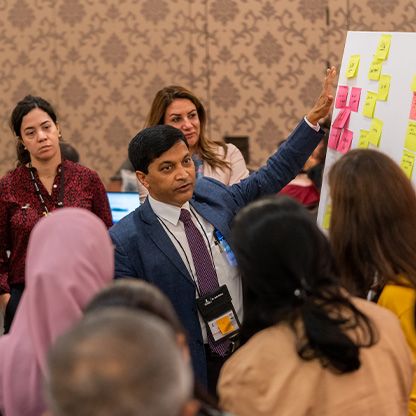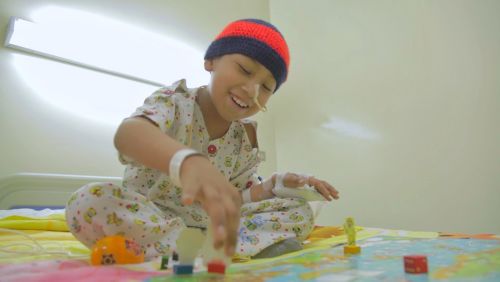St. Jude Family of Websites
Explore our cutting edge research, world-class patient care, career opportunities and more.
St. Jude Children's Research Hospital Home

- Fundraising
St. Jude Family of Websites
Explore our cutting edge research, world-class patient care, career opportunities and more.
St. Jude Children's Research Hospital Home

- Fundraising
Building blocks: St. Jude Global guides reestablishment of health care capacity during crisis
St. Jude Global, alongside Ukrainian clinical partners and NGOs, laid out recommendations for strategies to promote sustainable care for children with cancer.

Reassembling the pieces of a functioning healthcare system after a crisis such as a war can be a challenge – but St. Jude global partnered with colleagues in Ukraine to provide a framework for how to rebuild. Artwork by AnnElizabeth White.
Memphis, Tennessee, February 13, 2024
By Erin Podolak, MA
Disruption. On a small scale, it could mean the closure of a clinic or a specialist care provider who moves away. But what about on a large scale? Crises such as war create massive disruption, upending entire health care systems from infrastructure to personnel to supplies to funding. With so many puzzle pieces to reassemble, what is the best way to approach rebuilding a health care system to ensure it has the capacity to provide care for the people who need it?
The full-scale war in Ukraine, which began in 2022, brought such questions to the forefront for the team from St. Jude Global and their Ukrainian partners. There was a crush of childhood cancer patients who left Ukraine to pursue cancer care elsewhere through the SAFER Ukraine initiative at the start of the war. Since then, the Ministry of Health of Ukraine, the professional pediatric hematology-oncology community and non-governmental organizations (NGOs) have worked to sustain and improve the quality of care for Ukrainian children with cancer in their home country. But first, they had to consider a multitude of factors. How many patients were going to need care? Were there enough clinics to meet needs? How could health care providers continue their training? Were the needed medicines available?
St. Jude Global, alongside Ukrainian clinical partners and NGOs, provided some answers. In a report produced for the Ministry of Health of Ukraine and recently published in the Lancet Oncology, the team laid out recommendations for strategies to promote sustainable care for children with cancer.
“This is a good example of the role that St. Jude can play in supporting childhood cancer care globally,” said the corresponding author of the report, Asya Agulnik, MD, MPH, St. Jude Global Critical Care and Euro Regional Program Director and St. Jude Department of Global Pediatric Medicine associate member. “St. Jude can serve as technical experts, but then also bring together multiple partners around central issues in childhood cancer care globally to guide health ministries as they make important decisions.”
Puzzle pieces: How to reassemble a health care system
In the Lancet Oncology report, Agulnik and her co-authors list displacement, damage to critical infrastructure, health care funding constraints, disruptions in the medical workforce and cessation of education and research activities as significant contributors to the upheaval that can be found in a health care system following and during a crisis.
To rebuild, the team identified the following priorities:
Access to health care facilities: Timely access to essential health care and diagnostic services is integral to childhood cancer treatment but requires health care facilities that are safe, staffed and have the necessary resources. Roads, transportation, communication systems, electricity, water and sanitation systems all contribute to the facility’s safety.
Centralization of childhood cancer care: Consolidating resources and expertise through specialized centers results in improved pediatric cancer outcomes.
Safeguarding health care financing: During a crisis, public health care funding decreases due to lower taxation and shifting priorities, resulting in a heavy reliance on humanitarian and external resources. Coordinated distribution of external resources while raising domestic revenue is crucial to promote long-term sustainability and resilience of the health care system.
Reestablishing medical training: The medical workforce is integral to a functioning health system; therefore, restoring and maintaining a well-trained workforce through medical education is necessary.
Securing medication procurement: Availability of cancer medications, such as chemotherapy, is crucial for reestablishing cancer care, but financial and logistical challenges affect affordability and access.
National and international collaboration: Effective medical care often requires a collaborative approach across disciplines, professions, institutions and countries. Such teamwork requires an interdisciplinary health care workforce and international expertise.
“The challenge is you need all these components for the system to function,” Agulnik explains. “If you don’t have medicine, you can’t treat the cancer. But if you don’t have a trained workforce and you have the medicine, you still can’t treat the cancer. So, it is a matter of thinking about how to address multiple components of a complex system.”
“Not all of those elements need to be accomplished by the same actor,” she adds. “There are examples and opportunities of how you can use private-public partnerships and leverage foundations and outside funding to address the needs.”
Capacity counts: Understanding who needs care
Knowing how to rebuild a system hinges on understanding the need before you. The war in Ukraine greatly damaged civilian infrastructure, with 1,280 verified attacks specifically on health care infrastructure as of October 2023, according to the World Health Organization. Additionally, over 7 million Ukrainians sought refuge abroad, and another 6 million were internally displaced across Ukraine. Children make up about 50% of the refugee population.
The Ministry of Health of Ukraine had a baseline of the childhood cancer situation prior to the war: over 1,000 children per year diagnosed, approximately 150 physicians providing pediatric cancer care and over 30 facilities with a total of 855 inpatient beds for childhood cancer treatment. But what about after the war broke out?
Over 1,300 Ukrainian pediatric hematology-oncology patients were evacuated out of the country through SAFER Ukraine. Additional patients left the country through other mechanisms, but their number is unknown. For a time, this evacuation decreased the number of children with cancer in the country. However, children have continued to develop new cancer diagnoses or experience relapses, and over time, some children who relocated have returned to Ukraine.
“The unique thing about this scenario is because so many patients left the country or were evacuated as part of SAFER Ukraine and other efforts, the ministry was actually starting from a completely unknown place,” Agulnik said. “It was rapidly changing over time in a way that wouldn’t have happened normally. You need to have some sense of what the number is now — and how quickly it will change — to create policies and plan.”
Agulnik and her colleagues used data modeling to estimate that approximately 630 children would require pediatric cancer care in Ukraine by the end of 2023, with the number rising to 700 in 2025. The number of pediatric cancer patients in Ukraine is estimated to increase steadily as children return to their home country.
“As of now, most children with cancer who either are newly diagnosed or have relapsed can be treated in Ukraine,” said Agulnik. “We hope this modeling can guide decision-making and further planning of pediatric cancer care delivery in Ukraine.”
Lessons for the future
While there are unique characteristics that impact the care delivery methods based on the country and the nature of the conflict or crisis, the report in Lancet Oncology provides a framework for how to think about the necessary components of a functioning pediatric cancer health care system. The team underscores the importance of synthesizing what is known in the available literature with the country and crisis context and the knowledge of the many stakeholders on the ground who will carry out recommendations.
“Even though things might change in the future, health ministries must make decisions now. This report provides a framework to think about how to do that, even though there’s a lot of uncertainty,” said Agulnik. “Working with uncertainty is something we’ve learned much about over the last few years. It’s more of a question of ‘How do you achieve success in a shifting environment?’ We wanted to provide a framework for how to approach that and outline the targets and objectives to keep in mind as we do.”
“It creates generalizable knowledge that can be used in other scenarios because the approach of what we did could be done again,” she added. “The context may differ, but many of the strategies and processes could be replicated.”
Agulnik also highlights that the ability to do this work depends entirely on building trusting relationships before anyone can build or rebuild anything else.
“We are in a position of trust with the Ministry of Health, where they know they can reach out to us, and we will bring stakeholders together to help them address these very challenging issues while integrating literature in context.”


